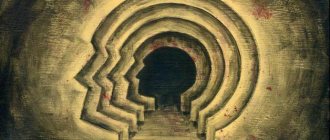All the facts about society, relationships between people, motivation and emotions that we know are the result of many years of work by sociologists, psychologists and sometimes even marketers. All of them have changed the world and the way we perceive it in one way or another. We re-read Sandy Mann's book “Hacking Psychology. All psychological theories in one book” and talked about the 9 most famous psychological theories.
Theory of perception
We have hearing, smell, sight and taste - channels through which information from the world penetrates us. But this is not enough, this information still needs to be realized; the process of awareness is perception. Thanks to him, we know exactly what an orange smells like and can distinguish it from a lemon, and we also correlate a person’s face with the rest of his body so that we can see it as a whole, and not in pieces. Several theories of perception have been developed throughout human history.
Gestalt theory of perception. The brain is constantly looking for understandable shapes and images in the environment. Therefore, we can easily find a rectangle on the phone screen, and an elephant figure in the cloud. Gestalt theory has three principles: according to the principle of proximity, objects located close to each other are perceived as one; According to the principle of similarity, objects that are similar in shape or weight are perceived as connected. And unfinished figures make us feel uncomfortable. Therefore, we see the letter “X” as a letter, and not as separate lines - this is what the principle of closure says.
The theory of direct perception by J. Gibson, one of the most famous psychologists of the 20th century, says that we perceive the world through affordances - the qualities and functions of objects that help us evaluate the possibilities offered by these objects. For example, a pen is needed to write, and the shadow of an object allows us to hide from the sun in the heat. And only by realizing these properties can we perceive an object.
R. Gregory's top-down theory of perception appeared in contrast to J. Gibson's “bottom-up” theory, and, according to it, we do not have to analyze incoming information. Perception is just a hypothesis that we build based on what we see, hear or feel, but we can also be wrong, although most often we are right.
Theory of pain perception. According to this theory, the perception of pain is influenced by more than just the senses, because the same injury can be felt differently in people. For example, according to pattern theory, the brain has its own typology of pain, thanks to which it identifies a particular signal. Because of this, the minimum level of discomfort may simply be a sensation, but there is a certain threshold of activation, after which the sensation is already interpreted as pain. Each person's thresholds are individual.
Psychoanalysis
Psychoanalysis has a completely different approach. Here, any action is regarded as the result of interaction between three human entities: I, It and Super-Ego.
Goal It is to achieve satisfaction of needs, to gain pleasure. The super-ego embodies internalized norms, rules established in society, prohibitions. Between these two entities is the Self, which is trying to organize impulses, develop ways to protect the personality, look at the world intelligently and correspond to it.
Human behavior will depend on the strength of instincts, social norms, and a person’s own ability to choose successful actions that meet a specific goal.
In the process of life activity, the ego is not always able to cope, for example, with the influence of unsatisfied primary needs. As a result, it develops special means of defense.
- Regression into child behavior and attitude occurs due to the inability of an adult to cope with his responsibilities. Memories of childhood, where it was safe and good, make you feel sad for those times, try to find a strong person who can provide protection, and obey him.
- Projection and identification are associated with the transfer of thoughts, emotions, and actions to another person. Often such protection arises in young couples when the girl tries to imagine that her boyfriend sees the world exactly the same way as she does. At the same time, projection is associated with the transfer of unacceptable desires and thoughts, and in the process of identification, on the contrary, the other person becomes the owner of the qualities that you like.
- In the process of rationalization, only information that contributes to social approval of behavior is used. The smoker refuses to believe that smoke bothers others. But he is absolutely sure that a smoking break helps establish social contacts.
- Repression is another defense mechanism that influences behavior. Consciousness helpfully promotes forgetting the motives for actions that turn out to be unacceptable.
Another defense mechanism is sublimation. Thanks to him, unspent energy associated with instincts is transferred to creativity. Hence the bright, non-standard behavior, the ability to improve the oppressive atmosphere in the family and team.
Theories of attention
According to the general theory of attention, our perception works only when we pay our attention to a specific stimulus. This can be either pain or events happening around. Accordingly, if we believe that something deserves our attention, then we feel it fully, while insignificant things rather elude the senses, we are not aware of them and, as a result, we do not perceive them.
Broadbent's model of attention. A person has selective, that is, selective attention - this is the so-called sensory buffer installed in our head and filters the information entering the brain. It lets some stimuli through, and we react, but some don’t, and nothing bothers us.
In opposition to this concept, the attenuation theory was put forward, authored by Anne Marie Triesman, a psychologist who studied selective attention. She adheres to the idea that the sensory buffer, invented by Broadbent, does not remove some signals, but attenuates them. Therefore, from several sounds we can isolate the main one and concentrate on it, while the rest will be muffled.
The uniform encourages police to commit violence.
According to American psychologist Maria Konnikova, citizens don’t just associate police uniforms with aggression; they can influence law enforcement officers themselves, giving rise to outbreaks of violence. In an article published in The New Yorker, Konnikova argues: “When police don riot gear, they stop being ‘just cops’ and begin to feel like they are part of an overwhelming state military apparatus.”
Theories of memory
Memory is what allows us to remember every morning how to move, talk, type on the phone or prepare breakfast. This process includes 3 stages:
- storing information (encoding)
- data storage
- information extraction
All existing theories of memory are designed to explain how we store and use information. Here are the main three:
According to the Atkinson-Shiffrin multi-storey model of memory, a person has three main memory systems: sensory (primary information that is not stored for a long time), short-term (active information processing for 20-30 seconds) and long-term (information that we remember almost always).
Baddeley and Hitch's model of working memory arose to counter the shortcomings identified in the previous theory. The authors of the concept divided short-term memory into three parts - the central control element, the phonological loop and the visuospatial sketch. The central control element is needed in order to receive and store sensory information, and then distribute it along two other channels: auditory - into the phonological loop, visual - into the visuospatial sketch. They also introduced the concept of an episodic buffer, which links all information into a single whole. With its help, an object is perceived not in parts, but as a combination of visual, sound and verbal information.
Craik and Lockhart's levels of processing model focuses more on long-term memory. According to the multi-storey model, information moves from short-term memory to long-term memory through repeated repetition. Scientists Craik and Lockhart believe that this is not necessary. If we are faced with a problem related to some decision or event, then through careful and multifaceted processing we will remember this information - even without memorization.
Intentional position
If you want to get a clear understanding of theory of mind, your best bet is to read Dennett's 1987 paper. All of the following works on theory of mind are simply variations of what is presented in The Intentional Attitude. In his work, Dennett establishes the basic terms for how theory of mind works: desires are what people want, and beliefs are what they know. People use what they know to get what they want. Dennett argues that there are calculus for how beliefs and desires work together, but in order to perform these calculations, one must adopt an intentional attitude.
Found a violation? Report content
Learning theories
Learning is a long-known process to all of us, which is defined as a constant change in behavior as a result of gaining knowledge and experience. There are also three main theories here.
The theory of classical reflexes. Its principle of operation is perfectly illustrated by the well-known experiment with Pavlov’s dog. If a dog is regularly given some kind of signal before eating, then it will react with profuse salivation not to the fact of food itself, but to the signal - at the level of reflexes it will be associated with food.
Operant conditioning theory. It is based on the use not of some signal, but of a system of rewards or punishments. If, for example, you set yourself a task for the day and were able to complete it, then in order to consolidate the result and repeat positive behavior, you need to praise yourself. For example, relaxation, delicious food or something else that will make you happy.
Social learning theory involves learning in groups. That is, a person masters skills through observation or imitation (also called modeling). This theory differs from the other two in that it refers not only to reflexes, but also to cognitive processes occurring in the head.
Yawning is needed to keep your brain alert
According to Andrew Gallup, assistant professor of psychology at the State University of New York, yawning has important biological and psychological functions. Gallup believes that people yawn, firstly, to keep the brain at a normal temperature and increase its efficiency, secondly, to attract attention from others (this explains why yawning is so contagious), and thirdly, yawning may be a reaction to stopping taking certain medications.
Theory of emotions
For many years, scientists have studied emotions, where they come from and how they manifest themselves, but, most importantly, researchers have always been interested in the question of what happens in a person’s head when he experiences emotions. The most famous concept is Schechter and Singer's two-factor theory of emotion. According to their idea, the experience of emotions is based on two factors: physiological arousal and cognitive interpretation.
Previously, that is, before 1962, the year when this theory appeared, it was generally accepted that emotions were based solely on physiology, and mental processing had nothing to do with them. The two-factor theory says that first, when we experience any emotion, physiological arousal occurs, after which we begin to look for clues in the world around us in order to interpret it correctly. If, for example, we are sweating because we were running to catch the bus, then this will not be perceived as an emotion. And if we don’t find an objective explanation for what’s happening (because we didn’t run anywhere), then we begin to interpret it as excitement, fear, or something else. And only then do we recognize a specific physiological manifestation as an emotion.
Goal template
When we are looking for a way out of a difficult situation, for example, trying to cross a busy street, first of all we must identify the main source of danger for ourselves.
The Goal Pattern is a guide for finding similar arrays of stimulated complexes. And video games can help you with this. Despite the fact that many people talk about the dangers of playing a lot of video games, there are actually some positive aspects to them. For example, they are an ideal trainer for searching for and identifying hazards and scanning difficult situations. And the more action-oriented the game, the more impetus you get to train your attention.
And then I immediately remembered how the neurologist of my friend’s child said: “But he better play this more often!” after she saw one of the games on the wii. “It develops fine motor skills and intelligence well!” — the advanced aunty doctor added in parting. And that was 5 years ago 
Theories of intelligence
In addition to what emotions are and how they appear, scientists were no less interested in the question of intelligence. Researchers have tried to decide how to measure it, whether one person's intelligence is different from another's, and what influences this. There are two major theories here.
Spearman's two-factor theory. Intelligence is influenced by two types of factors: general and specific. The general factor is an innate and universal ability that is common to everyone, and the specific factor is the acquired skills that may differ among people depending on their experience, knowledge and interests. That is, for example, a violinist musician most likely knows how to walk and talk, but, in addition to this, he also has musical skills.
Gardner's theory of multiple intelligences. According to this theory, a person has 9 types of intelligence, each of which is responsible for a specific area of human activity. These include verbal, musical, logical-mathematical, figurative, bodily, social, intrapersonal, natural and philosophical intelligences.
Hand washing helps relieve guilt
Many studies claim that there is a connection between moral and physical cleanliness. Psychologists Chen-Bo Jeong and Katie Liljenquist asked participants in their experiment to hand-write a story about an ethical or unethical action (helping a colleague or harmfully interfering with his work) and then asked them to rate the attractiveness of different products. People who wrote about unethical behavior rated hygiene-related products, such as soap and toothpaste, higher.
In 2013, Oxford scientists tried three times to reproduce this phenomenon on participants from Britain, the USA and India, but all attempts were in vain. They do not claim that there is no connection at all between moral and physical purity, but they note that ideas about this phenomenon should be carefully reconsidered. Another 2011 study also failed to replicate these results.
Theories of motivation
Motivation is an internal or external stimulus that inspires us to perform a certain action. All theories of motivation are divided into substantive and procedural. Substantive theories, the subject of research, are the identification of human needs that drive us in decision-making. Process theories study motivation in principle, where it comes from and how it is maintained.
Maslow's hierarchy of needs theory. Maslow's triangle, or pyramid, has been known to us since school social studies lessons. All needs are divided into: physiological, the need for safety, social needs, the need for self-esteem and the need for self-actualization. The first four needs are considered basic needs, without the satisfaction of which a person will not be able to satisfy the “highest level” need, i.e. the need for self-actualization.
Herzberg's two-factor theory. It is also called motivational hygiene. According to this concept, there are two sets of characteristics that influence satisfaction. The first set are factors whose presence increases satisfaction, the second set are factors whose absence increases satisfaction.
Vroom's expectancy theory, unlike the previous two, is a process concept. According to Victor Harold Vroom, a person is motivated to perform an action by 3 factors: expectation (if I try, everything will work out), facilitation (if I try, I will be rewarded) and valence (I really want to receive a reward).
Babies have an innate ability to imitate
Pick up almost any introduction to psychology and you'll find a story about 1970s research showing that people are born with the skill of imitation, accompanied by black-and-white photographs of a person sticking out his tongue and a baby responding in kind.
But a 2021 study found no evidence for this hypothesis. Janine Oostenbrock and her colleagues tested 106 infants four times, ranging in age from one week to two months. The researchers made different facial expressions for a minute and recorded the child's response.
This study was more comprehensive than previous ones, as it used about a dozen different expressions and sounds. But no confirmation of the hypothesis was found. Psychologists Richard Cook and Daniel Yohn note that it is likely that people are not born with the ability to imitate, but rather learn it gradually.
Theories of social psychology
Humans are social creatures who prefer group work rather than individual work. It is important for us to be part of something larger - a family, a work team or an interest group. And one way or another, people within their team influence each other, which is what many socio-psychological theories try to explain.
Hawthorne effect. Named after an experiment at the Hawthorne plant, where a group of researchers observed workers over several years to find out how lighting affected labor efficiency. The Hawthorne effect was an indirect result of a study that revealed that it was not the working conditions that influenced the results, but the fact of having an observer who monitored their work.
Minority influence theory. It is commonly believed that the majority usually influences the minority, but experiments have proven absolutely the opposite. If a minority behaves logically, consistently, confidently and convincingly, then it can influence society. Therefore, one single person can lead a nation or, for example, become a catalyst for a revolution.
Social comparison theory. Initially, each person seems to be braver, kinder, or more correct than the rest of the majority. However, many experiments have shown that during group discussion, participants discovered that other people were in some ways stronger or kinder than them, or in some ways adhered to better ideals and values. And then all the participants began to try to show themselves in a favorable light in order to keep up with the group.
Self-affirmation. I am the most charming and attractive!
Often positive self-affirmations make people stronger internally and give them a much greater chance of success in achieving their plans. However, there is a certain risk in this approach. A recent study showed that overconfident people sometimes find it very difficult to start again when they fail. And how much to heart you took this failure may show that your chances of success in your future activities are, in fact, much less than you thought.
Relationship theories
Psychologists have been studying for many years the question of how one person develops an attitude towards another person, event or opinion. According to them, attitude consists of three components: emotional, behavioral and cognitive. And any attitude can cause a certain action, so it was important for scientists to find out whether it is possible to influence this attitude, thereby changing subsequent behavior. Here are three main theories.
The theory of reasoned action. According to this theory, our behavior is influenced by attitudes towards that behavior (positive or negative) and social norms (the views of those around us on such behavior). For example, if a person has a positive attitude towards smoking, but his family is against it, then these two factors will influence the decision whether to smoke or not.
Theory of planned behavior. The implication is that there is a cognitive explanation for each behavior. For example, you decide to go on a diet because you think it will be good for your health. Or you decide to stay home and not go anywhere because it’s raining outside.
A probability model of conscious information processing. This theory explains how a person forms or changes his attitude. There are two ways: central and peripheral. The central method is to consciously process information, compare the advantages and disadvantages of a certain action. Characteristic of those people who are motivated to make any changes and are looking for ways to implement them. The peripheral method does not involve deep information processing, but people’s feelings and emotions. That is, a person is more likely to change his opinion if the arguments are given by someone he likes, regardless of the quality of the arguments.
Dark Triad
The dark triad is a combination of narcissism, psychopathy and Machiavellianism (brute force, disregard for moral standards, etc.). And it doesn't just sound bad. This is really bad in most cases. Usually, these are people who bring a lot of suffering and trouble to others, and loving such a tyrant is real torture. But, nevertheless, during the research it was found that it is these traits that contribute to career advancement. People with these traits are incredibly persistent and productive. Moreover, they outperform their more conscientious, slightly obsessive-compulsive (repetitive behavior) counterparts.
Reflexology direction
Reflexology (reflexological direction in psychology) is a natural science direction in psychology that considers mental activity as a set of reflexes formed as a result of the influence of the external environment on animals or humans. This direction is part of domestic psychology.
Reflexology: I.M. Sechenov, I.P. Pavlov, V.M. Bekhterev
This direction arose at the beginning of the 20th century. THEM. Sechenov is considered the founder of reflexology. He substantiated the reflex nature of the psyche, discovered brain reflexes and central inhibition. Sechenov’s entire theory was built on the concept of “reflex”.
I.P. Pavlov created the doctrine of conditioned reflexes. They arise throughout life and can change and disappear. Conditioned reflexes are individual, they also contribute to adaptation. Pavlov introduced the concept of “first signal system ,” which forms the basis of higher nervous activity (HNA) and is reduced to a set of different conditioned and unconditioned reflexes to immediate stimuli or their traces. The second signaling system, in his opinion, is speech.
V.M. Bekhterev proposed the doctrine of combination reflexes. According to his views, the influence of two stimuli must occur adjacently in time for the formation of a combination reflex. In his opinion, the human psyche is built on the principle of combining new experiences with traces of the old. Bekhterev also studied issues of the individual and the collective.











